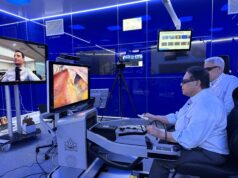By James White
Approximately 5–6% of deaths occurring annually in North America are classified as sudden cardiac death, a designation indicating its occurrence within one hour of symptom onset. Patients with resuscitated sudden cardiac death or sustained (>30 seconds) ventricular tachycardia represent a particularly high-risk population for future sudden cardiac death and typically undergo a battery of testing in an attempt to identify a clear precipitant of the event. This is typically inclusive of echocardiography, invasive angiography and the selective use of other more specialised imaging tests. However, the diagnostic yield of cardiac imaging in this clinical setting has not been evaluated.
Cardiovascular magnetic resonance (CMR) imaging has evolved to provide comprehensive evaluations of cardiac morphology, function and tissue health. The latter, inclusive of T2-weighted “oedema” imaging, T1-weighted “fat” imaging, and delayed enhancement “scar” imaging provides a potentially robust platform for the evaluation of arrhythmia substrate. In our recent publication (White J A, et al Circulation: Cardiovascular Imaging [2012] 5:12–20) we evaluated the diagnostic yield of CMR imaging versus all other clinically ordered imaging tests among a consecutive series of 82 patients presenting with resuscitated sudden cardiac death or ventricular tachycardia.
Patients with clinical evidence of ischaemia were excluded. The study identified that the detection of any relevant cardiac abnormality by non-CMR imaging was modest at 49% patients. Conversely, CMR identified relevant disease in 74% of patients, offering incremental detection of acute myocardial injury (i.e. associated with oedema) in 17% as well as the detection of unrecognised chronic myocardial disease. In those having resuscitated sudden cardiac death up to one-third of patients had evidence of acute tissue injury.
The tissue pathologies uniquely identified by CMR in this population were subendocardial-based ischaemic injury and subepicardial-based inflammatory injury; each identified both with and without associated oedema, a measure of disease acuity.
CMR was effective at identifying patients with arrhythmogenic right ventricular cardiomyopathy (ARVC) but also identified patients with other chronic injury patterns within the right ventricle attributable to inflammatory myocarditis.
This represents the first evaluation of diagnostic utility for cardiac imaging in patients presenting with ventricular arrhythmias. While recognising that contemporary advancements in non-CMR imaging, such as echocardiography-based strain imaging, were not evaluated, the study does identify that routine clinical non-CMR imaging may neglect relevant cardiac pathology in this cohort and accrues a relatively modest diagnostic yield. The use of CMR imaging achieved a more robust diagnostic yield and did so through its unique identification of tissue level pathology. Most importantly, acute tissue injury was identified in a significant number of patients.
The clinical relevance of re-classifying patients with respect to the presence of acute tissue injury by CMR is yet uncertain and requires ongoing study. By convention, clinically recognised acute ischaemic injury is considered sufficient justification of a transient arrhythmia precipitant to negate need for secondary prevention implantable cardiac defibrillator therapy. However, whether or not sub-clinical CMR evidence of the same should carry a similar recommendation is an interesting and debatable question. Accordingly, there is a need for prospective clinical trials and registries in this field to assist in answering these important clinical questions.
James White is a cardiologist, Cardiovascular MRI Clinical Research Program, MRI Unit, Robarts Research Institute, London, Canada.










